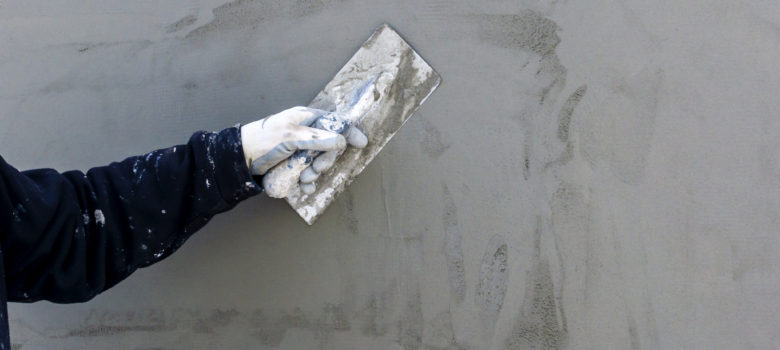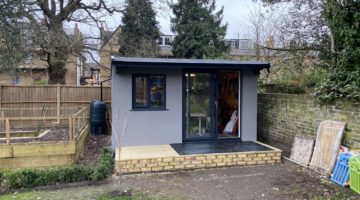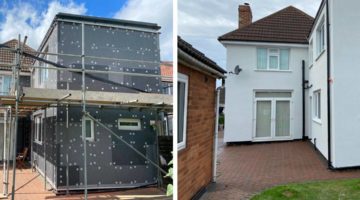
You may think, by reading the title of this blog, that we are about to suggest you attempt to cut costs by installing external wall insulation yourself. It is certainly not a DIY job! Unfortunately, you cannot just buy random materials to slap onto the walls, even if you are a competent DIYer; without proper manufacturers’ training or experience, there is a huge risk of a botched job.
So, if you can’t keep costs down by doing the work yourself, how can you? This blog concentrates on tips and tricks on how to go about maximising your knowledge of the process to ensure you are not throwing your money away – external wall insulation retrofit is expensive.
What is external wall insulation?
External wall insulation is essentially like wrapping the property in a blanket, which has multiple benefits. First of all, the property retains much more heat on the inside, therefore feeling a lot more comfortable. In addition, the heating system should work less hard, helping save money off heating bills.
Secondly, in the warmer months of spring and summer when the sunshine is more intense, external wall insulation keeps the internal environment nice and cool.
Finally, external wall insulation also repairs porous brick or masonry walls, and the outer layers of the system (with their flexible beading and renders), prevent moisture from penetrating the outer leaf of the walls.
What is the cost of external wall insulation?
External wall insulation is not cheap; it costs roughly 10x more than retrofit cavity wall insulation. We have interviewed a series of external wall insulation companies and have come up with estimated costs for a typical 80m2 floor space property – for a mid-terrace, end-terrace or semi-detached and detached.
| Type of Property | Estimated Cost of External Wall Insulation | Estimated Savings with External Wall Insulation |
|---|---|---|
| Mid-terrace | £6,000 to £8,000 | £120 |
| End-terrace / Semi-detached | £10,000 to £12,000 | £275 |
| Detached | £15,000 to £20,000 | £420 |
** Costs compiled interviewing a number of external wall insulation installers. Saving compiled using typical EPC data for similar sized properties in England.
Why does external wall insulation cost so much?
External wall insulation, as you will have gathered from the costs above, is an expensive measure. Cavity wall insulation on the other hand is cheaper, but unfortunately many properties in the UK do not have cavities and are therefore unsuitable. Properties built before the 1930s are usually solid brick construction.
Cavity wall insulation can be injected into the cavity using either blown fibre insulation or polystyrene beads. The preparative steps are relatively straightforward, with incisions made at various parts of the walls and a specialist machine used to pump the insulation in. This process is then repeated, elevation by elevation, until all available walls have been insulated. The process takes a few hours to complete and can be attempted without the need for scaffolding or other preparation works.
External wall insulation is effectively like a small building project, requiring scaffolding and various tools to enable the preparation of the insulation as well as installing the external plaster work. In addition, the external wall insulation process requires skilled tradesmen – ones that are good on the insulation and boarding parts and others who are adept at plastering and external rendering.
Each stage in the external wall insulation process requires the materials to dry properly before the next layer is applied. As the works are outside, the installation process is largely weather dependent, and this may well increase the duration of the whole project.
The cost of external wall materials alone is much greater than cavity wall insulation materials, which adds to the cost of the measure.
The reasons above of project complexity, weather dependency, skill of applicators and the cost of materials make external wall insulation much more expensive than cavity wall insulation.
In addition to that mentioned above, some properties are timber-framed or of metal construction and would require specialist external insulation solutions, such as cavity railing systems. These specialist solutions may add to the cost of the overall project.
Are there any grants out there for external wall insulation?
While there were a few grants in the past offering pretty generous funding towards the cost of external wall insulation, unfortunately those grants are no more. There is still ECO funding, but quite frankly the rates offered to installation companies are so low that they are not bothering taking on the jobs – with the paperwork involved, it is not worth their while.
Will the grants come back anytime soon? The answer is probably no, as there is very little money left and the appetite from central Government to fund domestic energy efficiency is waning.
The ECO mechanism is due to be reformed with ‘deemed scoring’ to come in the near future, and we wait to see whether it will be a more cost-effective process for the installers to take onboard.
Installing external wall insulation without a grant
Let’s return to the main conundrum of the blog, which is how to go about trying to maximise the benefits of external wall insulation without government funding.
Saving on external wall insulation costs by combining projects
If you – like many folks out there – are about to start a major refurbishment on your property (for instance taking on a loft extension and side return expansion works), carrying out the external wall insulation at the same time may just make sense.
Firstly, as already mentioned, the scaffolding is a fixed cost that one cannot get away from (unless you have a bungalow) and it typically makes up 10% of the external wall insulation project cost. For your loft extension or your extensive refurbishment, you are going to have to organise scaffolding anyway, and therefore it makes sense to try and combine the projects in a nice sequence, which will result in money off the final bill.

Good external wall insulation systems are flexible! The systems themselves add another layer of substrate and are finished off with flexible beading and a robust render solution, whereas traditional sand and cement do not have these benefits.
Combining external wall insulation with your neighbours or organising street-by-street approach
If you are going to do external wall insulation, then try to get your neighbours on the act if possible. For example, if you reside in a semi-detached property, it may make sense to do it as one project. This would increase the scale of delivery for the installer, reducing delivery costs. Fixed costs like scaffolding, delivery, material and labour mobilisation can be spread out onto multiple contracts so that the individual split contract is cheaper than if you did it as a standalone project.
It doesn’t matter as much even if you have a detached property, because if you can also get individuals, neighbours or family in the close vicinity involved in having the measure installed at the same time, then it gives you a much stronger contractual bargaining position with your contractor.
Insulate the problem areas of the property to keep costs down
Each property has its own energy efficiency and structural problem area. For example, in a typical town, an end-terrace property positioned next to a street corner tends to be more exposed due to the weather and wind velocity than a sheltered wall at the back of the house. This is the same with any wall/s that are exposed over areas without any buildings or vegetation in the way to reduce the impact of extreme weather scenarios. This is why properties near coastal areas, in the West of the country or countryside properties in large open areas are very exposed to ventilation losses and high speed driving rain due to higher wind speeds. You can see where you are on this map by referring to the relevant NHBC chapter.
Other effects:
- Larger surface walls by the nature of their size also account for greater heat losses in a property than smaller wall areas.
- North facing walls tend to be cold – north facing elevations absorb less infrared radiation from the sun, hence why rooms in those parts of the property are not only colder when not heated but much harder to keep warm when they are.
Due to these effects, some consumers very often complain from damp on these walls in the winter months, as they are not only very cold to touch from the inside, but because they are highly energy inefficient and exposed and so hard to heat and keep dry during this period of colder and more unstable weather.
External wall insulation is great because you can choose to prioritise the exposed walls, so only insulate the flank side wall that is very cold OR combine this wall with another north facing wall, therefore only targeting the really problematic areas and therefore saving you money off the overall project. For example, if you have a detached house, instead of insulating the whole property, (which may cost you in excess of £20,000), choosing to do the two most problematic walls may cost you just £12,000.
Finance your project
Without the grants being available or certainly if you can get some of the ECO funding secured, Financing the project may well be the most realistic option. A few years ago, home energy efficient improvement loans for new boilers, roofs, windows, etc were a rarity with high street lenders, but with energy efficiency standards now becoming talked about more and more, the finance products are becoming more readily available. Update: January 2017 – the Green Deal Finance mechanism is making a return, which should offer the ability of consumers to pay for some of the cost through the savings on the energy bills.
We have also seen independent and socially responsibly lenders enter the market recently with an increased pool of funding and highly competitive interest rates, which can lend £1000s towards projects like these to ensure they can happen.
Finance obviously isn’t for everyone, but it may therefore be possible to speak to your mortgage lender in the first instance to see what existing options they offer on the property with a mind for improvement as external wall insulation is precisely one of those things.
Go for maximum insulation – don’t just stop at 100mm
If you are going to insulate the property with external wall insulation, then don’t just stop at 90mm or 100mm of external insulation, go for the more ambitious 150mm and really bring those walls up to the highest possible standards. New build properties are now being designed with U-values of 0.16W/m2K or better, and this can be achieved on a retrofit too, if the right amount of insulation thickness is used.
The cost of the insulator like EPS relative to the whole project is not as significant as some of the other components of the project, therefore we encourage a conversation between yourself and the installer so that all these considerations are brought to their attention.
Installing solid wall insulation
Interested in getting solid wall installation? We have scoured the country for the best tradespeople, so that we can make sure we only recommend those we really trust.
If you would like us to find you a local installer, just fill in the form below and we will be in touch shortly!












We are looking to improveexternal wall insulation at a community centre in Wolverhampton. A builder’s quote recommends using 90mm EPS but we are wondering whether we could do better by using a higher quality material such as Kingspan. By way of cost benefit analysis could you estimate how much more 90mm of a better material would cost and how much we would benefit from improved heat retention?
While the Kingspan is a good material, it is probably more appropriate to have installed internally rather than externally. The EPS and Mineral Wool is more appropriate as part of EWI, as they are not prone to shrinkage over a period of time like some phenolics (leading to render cracking potentially). On the saving side – the calculation is possible but would depend on a number of factors including existing energy costs, property air infiltration rates and how the occupiers use the building.
I thought about doing this myself with Kingspan too. It strikes me that there is a massive gap in the market for affordable EWI. The figures bounded around of £12k-£20k are simply ridiculous. I’ve watched a few promotional video’s of EWI being done and granted the professional firms do a thorough job and I was amazed with the amount of stages in the process but even then, Projects coming in at around £20k is going to be cost prohibitive for a significant portion of UK households!?!?!?
Thank you for publishing this awesome article. I’m a long time
reader but I’ve never been compelled to leave a comment.
I subscribed to your blog and shared this on my Twitter.
Thanks again for a great post!
Very informative but does not answer my question which is:- Does fitting EWI avoid the problem of extracting failed CWI. ie does the wet CWI and any rubble dry out sufficiently to make costly extraction unnecessary? I have had conflicting answers from contractors!!!
You would have to make sure the Cavity Wall Insulation is sufficiently dry for even to contemplate fitting External Wall Insulation on the outer skin. If there is rubble in the cavity, wet cavity wall insulation mixed among all of it, then it really needs to be extracted, the cavity walls re-mediated, etc, potentially re-filled and then external wall insulation installed on the outside of it. The benefit of carrying out external wall insulation on the outside is that it would prevent weathering from the outer elements and add additional thermal efficiency to the existing property.